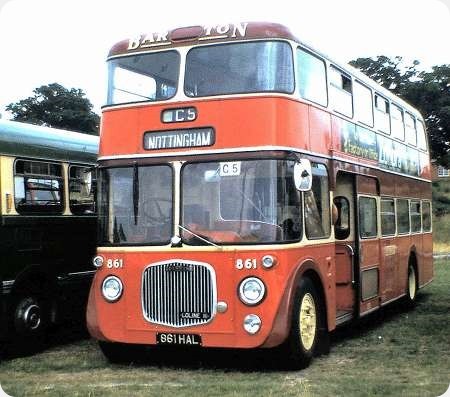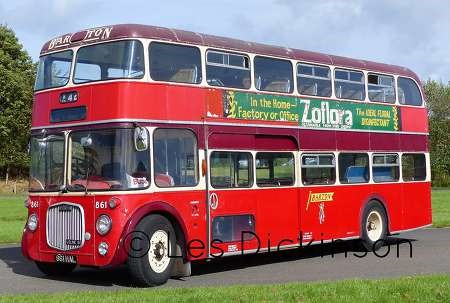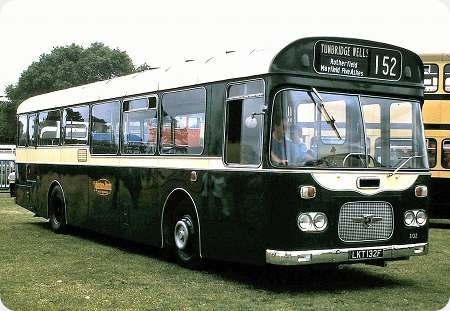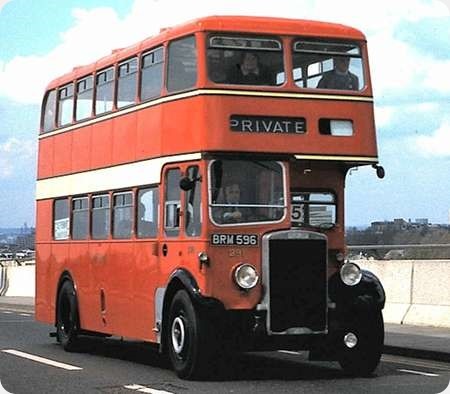
Barton Transport
1961
Dennis Loline II
Northern Counties FL37/31F
861 HAL is the famous ‘limbo dancing’ Dennis Loline II from the Barton fleet. It has an ultra lowbridge Northern Counties FL68F body and we see it at the Netley rally on 13 July 1986. How low can you go? Well, King Alfred’s WCG 104, Tiger Cub, is alongside – compare heights!
Photograph and Copy contributed by Pete Davies
17/11/16 – 07:08
Where does this Loline live now? A long-standing ambition is just to see it: riding on it would be the cherry on top.
Ian Thompson
17/11/16 – 07:09
So much has been written about 861 that I apologise if I’m repeating what’s gone before but for those who may not know, this ultra low Loline was purchased specially by Bartons to pass under an ultra low railway bridge at Sawley Junction station (now renamed Long Eaton) This it did, just, but Bartons proved it could be done. However, the Traffic Commissioners were having none of it and refused to licence the intended route for double deck operation. This left the company with a one-off vehicle with no real purpose but all was not lost for 861 because it became regularly employed on the X42 Nottingham – Derby express service where it put in some astonishing performances, up to 70 mph on the A52 road between the two cities. For most of it’s life it had a Leyland O.600 engine and also a regular driver too, a chap who was always immaculate in Barton’s brown uniform complete with striped shirt and bow tie, I never knew his name but he was known to everyone as ‘Flash Harry’ and a very competent driver he was. The X42 was jointly operated with Trent but those who knew and wanted an exhilarating ride chose Barton!
Chris Barker
17/11/16 – 10:36
Thanks, Chris and Ian. The PSVC listing for 2015 says 861 is part of the Barton collection, but I don’t know the location. A Wiki search gives me all sorts of museums, rare breeds farms and so on, but not what I’m actually seeking!
Pete Davies
17/11/16 – 10:37
This vehicle has become legendary, but I have never actually seen it. I don’t know if those alleged speeds are verifiable – the bus must have been very highly geared to get to 70 mph (I’ve got quite near to that in a 6LXCT powered Olympian). Nevertheless, I can vouch for the supreme stability of the Loline at high speeds, so 861 would have been entirely safe when motoring fast, especially so with such a low built body.
Roger Cox
17/11/16 – 10:56
Ian
861 currently resides in its old depot at Chilwell, along with the other members of the Barton Collection. The premises are usually open to the public during the Heritage Weekend in September each year. Well worth a visit.
Bob Gell
17/11/16 – 12:31
It appeared as part of the Barton display at Showbus this year. I believe the Chilwell site has approval for redevelopment, but don’t know how that will affect the Barton collection.
Ian Comley
17/11/16 – 14:40

As presented in the Barton line-up at Showbus 2016.
Les Dickinson
18/11/16 – 07:12
Given that the Loline was offered with a variety of engines, in this case the Leyland 0.600 being fitted, I’ve often wondered how 861 achieved such a low windscreen line together with what appears to be minimal engine intrusion beside the driver. It would seem to be much lower than, say, a Lowlander bonnet line or any other Lolines for that matter. For the technically minded, would the engine have been modified at all, or perhaps a shallower radiator fitted?
Chris Barker
18/11/16 – 07:17
Here is a link to my Flickr site where I have a set of 20 photos of Barton vehicles at Showbus 2016. Barton at Showbus 2016
Les Dickinson
19/11/16 – 13:38
Thanks for the info, gentlemen. I hadn’t realised that 861 was on the road, so I particularly regret not going to September’s Showbus—especially with all the other fascinating Barton vehicles there. To complement the ingenuity of the mechanical design and seating layout, everything about 861 looks well integrated: the very opposite of the afterthought-plastered-onto-afterthought appearance of some 1960s deckers.
Ian Thompson
20/11/16 – 05:49
Chris, like you, I am convinced that the radiator must have been repositioned or modified to achieve that low windscreen level, and the same is surely true also in respect of the similar bodies on the Barton Regent Vs of the type shown in this link:- www.oxford-chiltern-bus-page.co.uk/
Roger Cox
20/11/16 – 08:20
I take it, Roger, that the Regents weren’t ‘limbo dancers’ in the same was as the Loline – just broadly similar at first glance.
Pete Davies
21/11/16 – 07:50
If you compare the photos of other Loline 2s on this site, you can see that the radiator grille on 861 HAL is much lower, relative to the front wheels, than on other examples of the model.
Nigel Frampton
21/11/16 – 07:51
The clear recognition point between the Loline and the similar-looking Regents is the distance between the top of the wheelarch and the base of the windscreen and side window line.
But both are classic versions of a pleasing design that hasn’t been bettered by the more recent use of economical flat glass for windscreens. The wrap-around look gave a real sense of style, in my opinion. And, of course, much better visibility than certain modern buses with heavy non-glazed corner panels.
Peter Murnaghan
21/11/16 – 10:33
When 861 and Regents 850-4 were delivered they were fitted with the Cave Brown Cave heating system, so presumably they didn’t have a radiator in the conventional position. After only a few years, the CBC grilles disappeared, but it begs the question as to where the radiator is now. I remember one journey on 861 on the X42 with a new driver; I think he must have been used to the Regent Vs (four speed gearbox) as he never found fifth gear on the Loline for the whole journey!
Bob Gell
22/11/16 – 12:27
Fifth gear on the Loline I and II was engaged by pushing the stick forward from fourth into neutral, and then over to the right and back again in a ‘U’ movement. If the driver hadn’t been shown, he would probably never have found it. Changing back down from overdrive to fourth needed practice, too, to avoid engaging second gear by mistake. The trick was to move the stick forward into neutral and let it go, so that the detent spring could centre it properly, and then just pull it straight back into fourth.
Roger Cox
22/11/16 – 13:45
The curved front windows look natural on this bus and not out of place as they definitely do on the later Southdown Queen Mary Titans.
David Wragg
22/11/16 – 16:14
This would seem to be the same procedure as I used to observe drivers doing in the Dennis Lances, Roger, if I’m not mistaken, as I travelled from/to Woking Station and St. Peter’s Hospital, Ottershaw.
Chris Hebbron
22/11/16 – 16:15
Roger Thanks for the explanation of finding fifth gear (and getting out of it again!); is this similar to the 5 speed gearbox fitted to Bristol MWs?
Bob Gell
23/11/16 – 07:28
Whilst 850-4 and 861 had Cave-Browne-Cave equipment when new 957-62 did not and the radiators of tin-front buses were generally a lot smaller than the 1940s -style exposed items. I recall that unlike some Northern Counties full front bodies the regents did not use the manufacturer’s bonnet pressings. Perhaps the owner of one of the preserved examples could comment further.
Stephen Allcroft
23/11/16 – 07:29
In answer to Chris H, the Dennis ‘O’ type gearbox fitted to the Lancet, Lance and Lancet UF (though the few LU4 late examples had the Meadows gearbox) worked the ‘wrong way round’ from right to left, and was essentially a four speed sliding mesh (i.e. true ‘crash’) unit with a preselective overdrive on the end of it. To engage fifth the gear stick had to be pushed from the fourth position over to the left and forward. Unlike me, OBP contributor Ian Thompson has driven Dennis machines with this unique box, so he is our ‘in house’ expert here. The Bristol box, Bob, as fitted to the LS and MW, was a synchromesh unit working conventionally upwards from left to right, and I do have experience of it. Fifth gear was engaged from the fourth position by moving it to the right and forward. It was thus impossible to engage/disengage fifth except though fourth, which meant much labouring of the stick to get going again if one was baulked in overdrive. The Lodekka had the same gear positions, but in that case the gearbox was a constant mesh affair, making the extrication process from overdrive rather more difficult. Generally speaking, Lodekka drivers seemed very reluctant to use fifth in service unless a clear stretch of open road beckoned. By contrast, all versions of the Loline (the Loline III had a gear selector layout similar to the Reliance) allowed immediate access to neutral and the other gears from the fifth gear slot, and fifth was treated as the normal top gear. This feature alone meant that the Loline was a more sprightly machine on the road than the Lodekka.
Roger Cox
24/11/16 – 09:45
For those who would like more information on ‘Dennis ‘O’ Type 5 Speed Gearbox’ see this site:- //www.dennissociety.org.uk/nl/ogearbox.html
Roger Cox
25/11/16 – 07:24
Thx, Roger, for explaining much more about these gearboxes and that the ‘O’ was different from the Loline. You can quite see that drivers put on these vehicles without any advice, would have difficulty finding overdrive, or, if inexperienced, preferred the simplicity of avoiding it!
Chris Hebbron
25/11/16 – 10:37
One endearing thing about Dennis is that they don’t sheepishly follow the crowd. As Roger’s link to Ted Gamblin’s piece makes clear, changing into and out of the Maybach-designed overdrive on the Dennis "O"-type box is simplicity itself, whereas the other gears need rather precise timing. With the strange two-shaft box of the Loline I and II, on the other hand, you can hardly go wrong with any upward or downward changes, EXCEPT for the change down from fifth into fourth, which needs care not only in locating fourth properly in the gate, as Roger points out, but also in engine-speed matching. Having to go through first to engage and disengage reverse can also take you by surprise!
I may be over-generalising here, since the only Loline I I’ve ever driven is ex-A&D 357, currently out of action with gearbox problems.
It’s interesting that despite (or thanks to?) Dennis’s history of experimental and sometimes eccentric design, and their near-disappearance from the PSV market on several occasions, the company in its present form continues to thrive. Good that they escaped Leyland’s clutches!
Ian Thompson
29/01/17 – 08:43
With BartoN Transport Ltd family and employees we had somewhat different names for the vehicles than what the spotters and enthusiasts call them nowadays. For example the full fronted AEC regents were known as Derby Deckers nothing else, all the ex Londons were London Deckers the 30 foot AEC 470 saloon were known as Reliance (which they were) but the 590s were known as 36 footers. Any thing with a PD1 or PD2 engine was known as just that, we never used Tiger or Titan, or what the chassis originally was. A Vuemaster was that and only that regardless of what it was made from, body names like Vista and Vega were never used. The moggy pickup trucks were vans, the AECs with 3 seats one side and two the other were Jumbos.
Bill Redfern
25/02/17 – 16:30
The driver of 861 on the x42 Derby/Nottm express was Harry Bell or ding dong as we used to call him. His opposite was Ken Gardener also very smart with a dicky bow. I recall this very well as I used to drive 861 on a Saturday which was their day off.
Chris Coleman
05/12/17 – 14:25
I drove 861 the Loline on Saturdays overtime I was out the garage, worked on it a lot and went out to it on breakdowns, not everyone’s cup of tea. On Saturdays Red Michael the Russian conductor would sit at the back looking for police cars and I could do 70mph if not more he managed to get a drink each end Notts and Derby it was on the non stop Derby express, we were never late.
Bill Redfern
06/12/17 – 08:03
If 861 did 70mph then fully laden it must have been very sluggish as the gearing must have been high.
Roger Burdett
06/12/17 – 09:20
Quite so Roger, the engine would be seriously over revving to do 70mph, so if Bill saw this speed on the clock either it was over reading or it was in kilometres per hour (44 mph).
John Wakefield
07/12/17 – 08:48
Why would Dennis calibrate speeds in kph? I think Bill would know his 44’s from his 70’s! Some Barton buses used to make a lovely chuffing noise when "cruising" which I always used to think was their valves happily bouncing?
Joe
26/10/18 – 16:09
Having ridden in 861 during the 90’s. including a London to Brighton trip, out of Chilwell depot. It was a fast motor. The only problem was the steering judder. It meant we had to change drivers ever hour My dad Bill Mann was one of the team that saved it and helped bring it back to life. I think Bill Redfern might have been driving the bull that winched us up the pit at the depot.
Alistair Mann
02/12/20 – 06:37
In the Auto Review book 165 Bus & Coach Album 1 there’s a picture of 861 and it’s definitely 861 with a Regent V grille, not the Loline grille shown on the pictures above. It’s a shot of it in preservation. When was the grille changed and why?
Glenn Jones
03/12/20 – 06:36
Glenn, Bartons had a very competent fibreglass shop in their Chilwell works and they produced fibreglass replicas of the Regent V style grille, these were fitted when the originals had been accident damaged and not only to AECs, at least one of their full front PS1/B rebuilds had a pseudo AEC grille fitted and in the triangle where AEC would have been, they had carefully applied the name LEYLAND across the centre.
Such attention to minor details like that were typical and always pleasing to see.
Chris Barker




